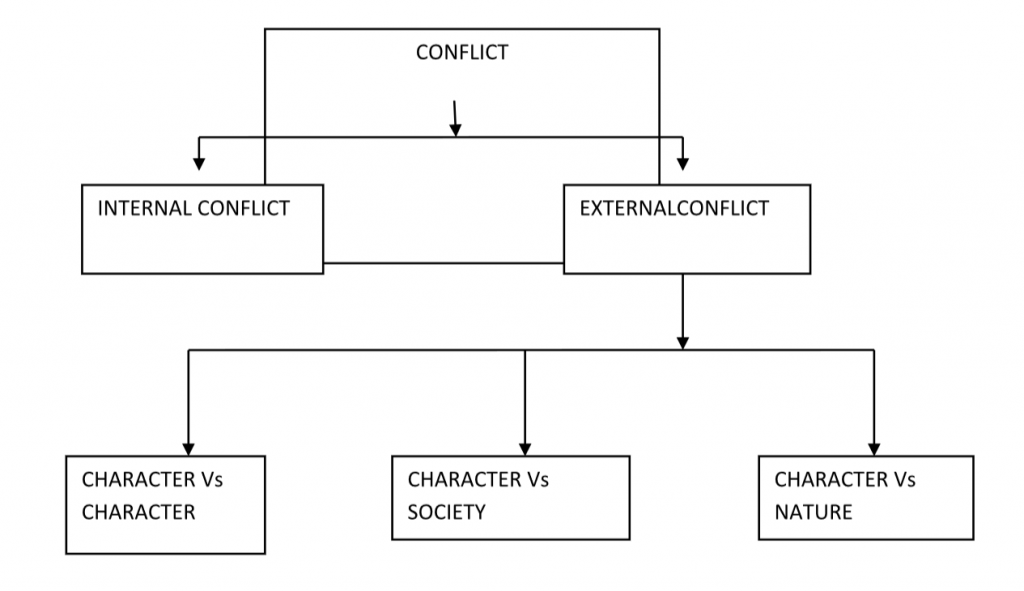Have you wondered what makes the plays of William Shakespeare and George Bernard Shaw to be successful? You will find that a common element will be present in all plays. It is like the salt in food, which adds taste to it. The magical elements these authors adopt is called conflicts.
What is conflict?
Conflict is a disagreement or clash of values, motivations, desires, or ideas. Conflict is what drives us humans to do great things in our lives, and it’s what propels our own stories forward. In writing, the presence of conflict creates narrative tension.
Conflict in a literature can be classified as shown below.

What is Internal Conflict?
Internal conflict is the struggle in the protagonist’s mind or a flaw in their personality. Its purpose is to create character growth and make a story resonate. It uses the struggle over the protagonist’s mind makes the play interesting. It communicates a theme to readers and make characters more believable.
Example for Internal Conflict:
In Shakespeare’s Hamlet, there are several moral internal conflicts. Not only does Hamlet struggle with wanting to kill Claudius in revenge, he also struggles internally with his own depression and thoughts of suicide.
What is External conflict?
It is the problem that the protagonist want to overcome. Its purpose is to drive the plot forward and make a story interesting. The external forces may be a character, nature, society or machines.
There are three types of external conflict:
1. Character Vs Character:
This type of conflict occurs when two characters with opposing viewpoints or needs are at odds with each other. Each character is carefully narrated to make the readers understand the conflict among them.
For example, in the Harry Potter series. Harry engages in a battle against Lord Voldemort.
2. Character Vs Society:
This type of conflict pits the protagonist against broader forces of society. The term forces may be social mores, conventional beliefs or Government administration. While society may be personified in one or more specific characters, these people typically stand as symbols or representatives of a larger system.
For example, Nineteen Eighty-Four by George Orwell. Winston, the novel’s main character, lives in a dystopian society with an all-powerful government that persecutes individualism and individual thought. While Winston is outwardly an upstanding member of the government party, he inwardly hates it which drives him to rebel against the party by entering into an illegal affair with a suspected informant named Julia.
3. Character Vs Nature:
Here, characters are threatened or kept apart by a natural force. That force may be represented by a powerful animal, a storm, an infectious disease, or some other natural phenomenon. Since is nature is considered as the supreme one, the character will accept it mistakes, flaws and survives it in most of the plays.
For example, Robinson Crusoe by Daniel Dafoe. One of the first English novels, Robinson Crusoe is a classic survival story of the titular character’s fight to survive when he’s washed up on a remote island.
Guide for Internal and External conflict in a literature:
1) Strong goals and obstacles for the character:
The main ingredient to convert your character to an alpha is a strong purpose such as destroying the evil forces in the universe, to win a competition etc. Yet this not alone enough; it should need a strong obstacles to prevent the character from achieving it. The obstacle should be competitive to the protagonist.
2) It is good to have a moral gray area:
A moral gray area presents your character with a choice or situation where right and wrong aren’t so clear cut. For example consider the plot of Robin hood, where he plunders to helps the needy and in this case there is conflict between character and government.
3)Use combination of both internal and external conflicts:
Consider the great plots, it will have both the combination of conflicts. It will make the literature lively and interesting.
Keep exploring EnglishBix to learn about different types of conflicts in workplace and organizations, and how to resolve them.

